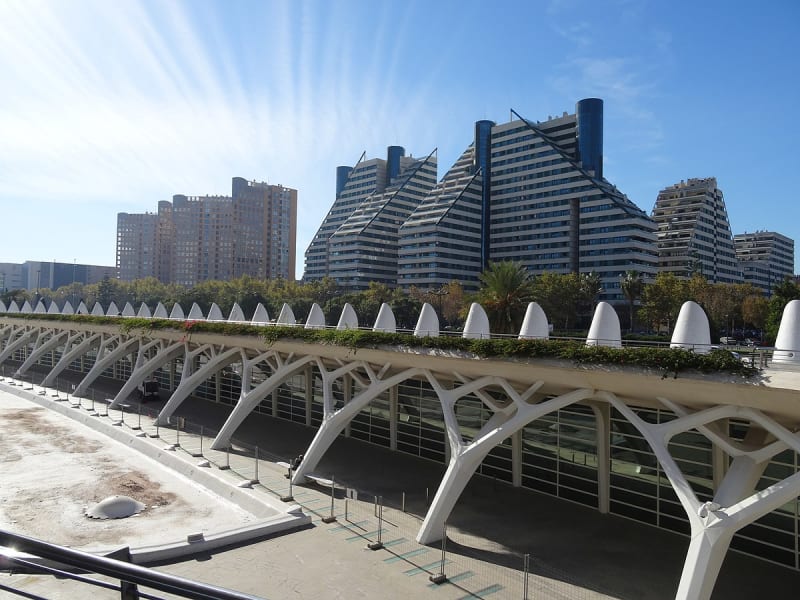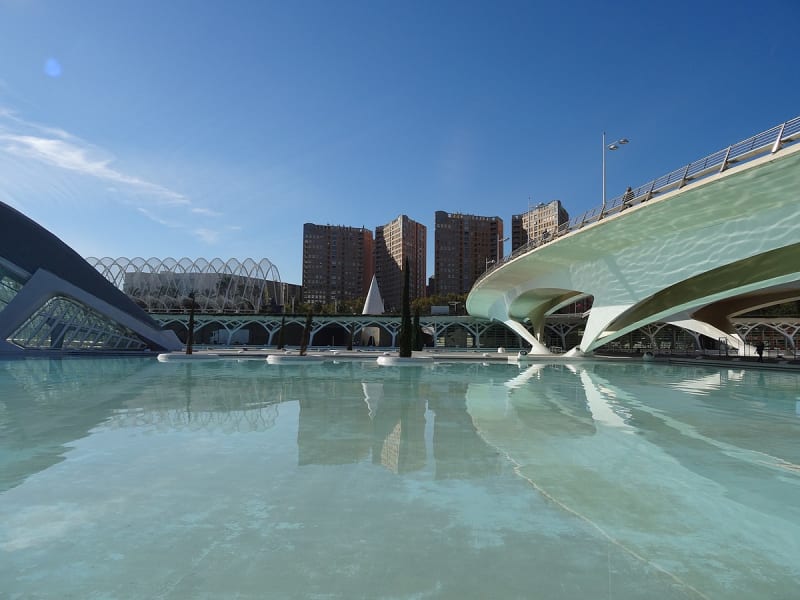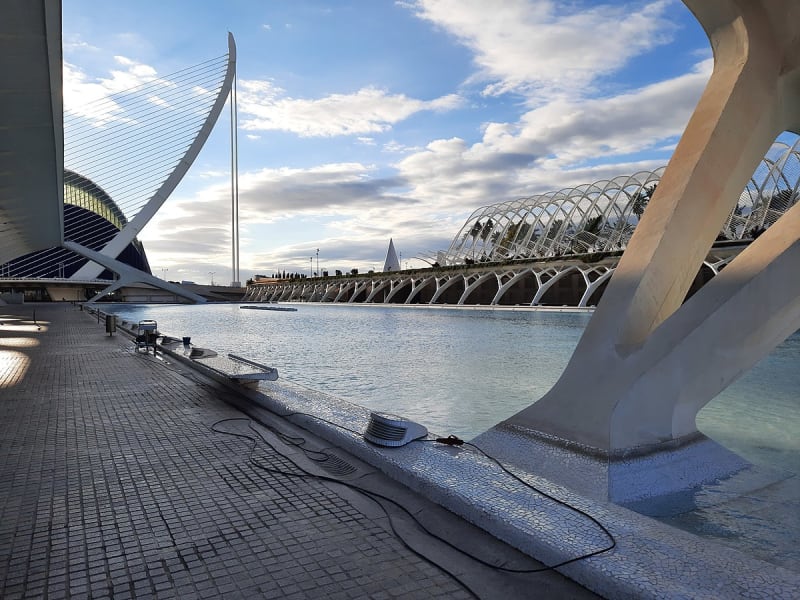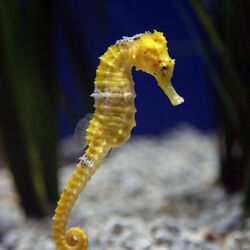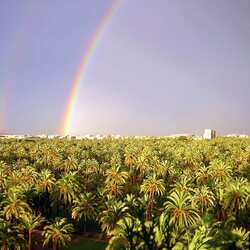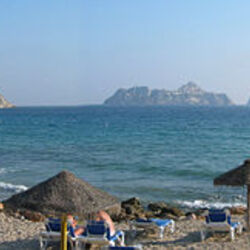City of Arts and Sciences
The City of Arts and Sciences is located in Valencia. Architect S. Calatrava began work on the unique complex in 1989. The design project of the unusual city was recognized as the best example of modern architecture. A futuristic city complex is spread over a plot of land of more than 2 square kilometers. The complex includes 5 buildings and unique structures.
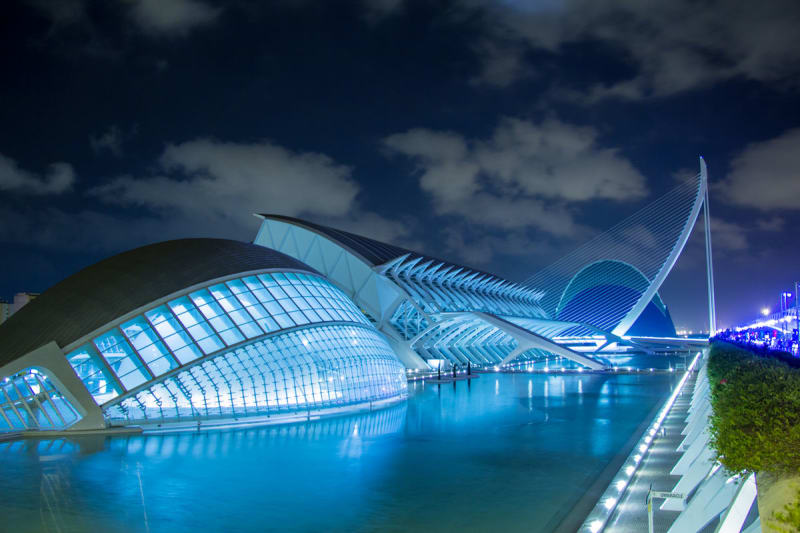
Reina Sofia Palace of Art
It was opened in 2005. Above the open doors of the seashell, an arch is gracefully curved, supported by a giant pylon - such an unusual shape of the palace is located between two pools. In one of the flaps there is a diamond-shaped hole resembling an eye. Some compare the shape of the palace to a fantastic helmet. The internal area of the palace is 40 thousand square meters, consists of 4 halls, ready to accommodate more than 4 thousand spectators. Another 2,000 spectators, located outside, can see what is happening on stage on a huge screen.
The opening of the first hall of the Palace was attended by Queen Sofia of Spain. The interior of the hall is decorated with mosaics in blue tones, creating a contrast to the white tiers of the balconies.
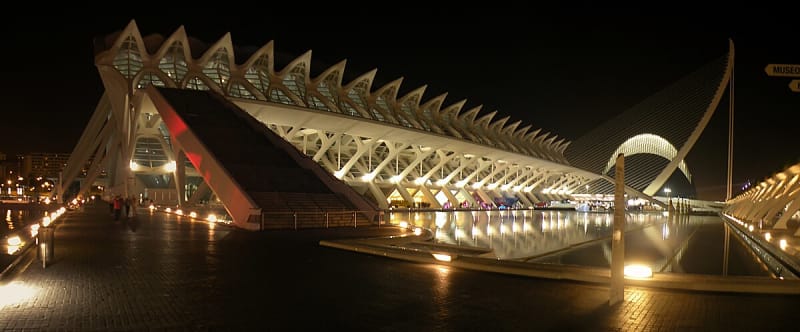
The palace, which has excellent acoustics, is designed for opera, ballet and any other concerts, as well as theatrical performances.
L'Hemisfèric
The building in the City of Arts and Sciences was the very first to open to visitors in 1998. It houses an IMAX cinema, a wonderful planetarium and a theater show for light and laser productions. The building is more than 100 m long and has an unusual roof shape - in the form of a giant egg, and resembles an all-seeing eye. The cinema's screen area is 900 square meters. m is the largest cinema in Spain.
Prince Felipe Science Museum
A science museum that demonstrates the latest technical achievements in an interactive and, above all, entertaining mode. The slogan of the museum is the phrase: "It is forbidden not to think, not to feel, not to touch!". Not only young people and curious tourists, but also representatives of science from all over the world are eager to attend scientific conferences held in the halls of the museum and exchange experiences.
L'Umbracle
It has been open in the City of Arts and Sciences since 2000. It is a magnificent botanical garden with rare plants and a gallery consisting of 119 transparent, almost invisible arches. More than 5 thousand representatives of fauna grow in the garden. In addition, there is an exhibition of works by artists and sculptors of our time. The equipped observation deck offers scenic views of the entire fantastic ensemble.
L Oceanogrofic
It was opened in 2002. It is an impressive oceanographic park and the largest aquarium in Europe. The main aquatic ecosystems of the planet have been created in separate aquarium zones. For example, the Mediterranean, typical for swamps, the Red Sea system, the Arctic, and the Antarctic. More than 45 thousand species of flora and fauna live in aquariums. There is also a huge dolphinarium. There is a magnificent underwater restaurant in the center, where you can watch the life of 10 thousand fish during lunch or dinner!
Assut de l'or Bridge
An amazingly beautiful snow-white cable-stayed suspension bridge stretches over the former riverbed. The column tower standing on it is the tallest in Barcelona. Its height is 125 m.
L'Agora
A huge indoor playground designed for concerts and sporting events. It resembles a giant ellipse with pointed ends, almost 90 m long and about 70 m wide. There's a huge ice rink here on Christmas Day.
The City of Arts and Sciences project provides for the construction of 3 giant skyscrapers, 308, 266 and 220 m high. Their construction has been postponed indefinitely. The complex has magnificent parks, streams and beautiful fountains.
A little history of the City of Arts and Sciences
In 1989, the now famous Jose Pinro, a professor of history at the University of Valencia, presented the idea of building a scientific museum on the site of the Turia riverbed to the head of Valencia, J. Lerma. The President supported the idea. It was decided to create an outstanding large-scale facility. A team with experience in creating original structures in Canada, Great Britain and Germany was invited to work on the ambitious task.
Initially, it was planned to spend about 150 million euros to implement the plan. The project provided for the construction of a Science Museum, a telecommunications tower with a height of 370 m - the third tallest in the world, and a planetarium.
In 1991, the lands were allocated, and S. Kalantrava presented his project. In 1998, the first building opened its doors to visitors. The City of Arts and Sciences is an invaluable decoration of Valencia and a favorite vacation spot for indigenous people and numerous tourists.



